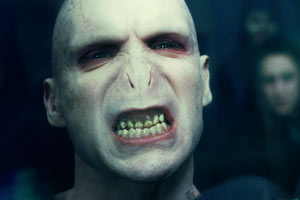Ever wonder why everyones favorite character is the bad guy? Darth Vader, Montgomery Burns, Dr.Hanniball Lector, Norman Bates - all of these characters and more have made the indelible mark on your psyche that most square jawed heroes cannot. What is it about the man in the black hat that so fascinates us? Is it that we see something of ourselves in these vile characters? Perhaps we pity their depravity or we sympathize with their journey into darkness. Maybe we admire their diabolical genius or their power over others. In any case, there is no question that the villain makes the story. Across all works of modern storytelling, a good villain will transform a bland piece of entertainment into an inspiring work, bordering on Homeric fiction. It has been said that the true measure of a hero is based on the quality of his nemesis. What is the hallmark of a true villain? What do villains have in common? This three part issue will take you deep into the 9 levels of villainy and unlock the secrets behind then characters we love to hate.
Level 1: The Cult
The first level and most innocuous of villain is the cult. This individual or group of individuals operate under the pretext of a great devotion, usually religious and often fanatical in nature. The cult uses secrecy and bully tactics to impose their will on others. The cult is at its most dangerous when they outnumber and isolate the hero. Under these conditions the cult is able to use its best weapon of intimidation to either suppress opposition or eradicate it. The villainy of these characters is often fueled by blind faith and/or cultural ignorance. Ultimately these villains are nothing more than misguided individuals, only doing what they have been taught to do by their leaders, their community, or fellow cult members. In the end the threat of this villain is brushed aside when armed with bravery, intelligence, and a modicum of ingenuity.

Examples of cult villains permeatee both classic and modern film. These fantatics can come in many shapes and sizes - both organized like the Thugee members and their mystical leader in Indiana Jones and the Temple of Doom, or they can be a disorganized rabble like the hillbillies from the movie Deliverance. In both cases they represent mankind falling victim to their more sinful impulsess. They are compelled to evil action not because they must, but simply because they want to and have justified their behavior through a flawed and broken belief structure.
Level 2: The Monster
The Monster has been a staple of storytelling for thousands of years. The earliest known Germanic story of Beowulf has the creature known as Grendal. In classic film, Frankenstein's Monster and The Wolf-Man elevated the place of monsters as primary villains. The Monster is typically a mindless (or at best single minded) creature of abnormal form. Often times this villain is considered deformed, "monstrous," or otherwise very imposing in some way. The Monster stalks our hero relentlessly through the story. It uses all of its talents to keep its victims guessing and often racks up a significant body-count before our hero manages to figure out a way of defeating it. The monster can be one of the most frietening of villains because it cannot be reasoned with or conviced to deviate from its present course of action. Unlike the other villains, the Monster is not taking evil action because it is inherently wicked. It does not see right from wrong or good from bad. It acts on instinct because it is "wired" that way.

This villainan device is one that predominates the science fiction and fantasy genre and is often not found in other genres. One very famous exception is the movie Jaws. This giant shark is monstrous in size and relentlessly tracks prey with great cunning. Other monster villains will instantly spring to mind such as the alien in the movie Alien. This is the poster child for the second level of villainy. In science fiction the robot can also be categorized as a monster. The HAL 9000 from 2001: A Space Odyssey, or The Terminator are both single minded entities programmed to carry out their orders. All are driven by an instictive (or programmed) force beyond their control and are relentless in their objective.
Level 3: Wayward Child
As we delve into deeper levels of villainy, we begin to find a greater depth of wickedness. The Wayward Child represents a fantatical ideologue. Unlike the cultist this villain is masked under a veil of educated sophistication or an expensive bank account. These villains almost always entice followers through their assets, be it wealth, power, of a charisma that defies explanation. Most (including their closest followers) are unaware of how deep their fanaticism goes and they believe themselves to have risen above humanity by virtue of their mission. That mission typically is one of single minded purpose that requires death in order to succeed. Ever the utilitarian, the Wayward Child sees his actions as a necessary act in order to realize the vision.

This villain is often confused with the cultist but when used properly can be a far more satisfying antagonist to the storyline. Examples of our "lost children" include Joe Pesche's character in Good Fellas, The Preacher from Buffy the Vampire Slayer, and perhaps more notable than any other - Harry Potter's own Lord Voldemort. In many cases they have all "fallen from favor" and walk a dark path in solitude. All of these men follow their own capricious, wanton, or depraved inclinations with complete disregard for everything and everyone around them. They operatete in secrecy until that secrecy is no longer necessary for their protection. At that moment they proudly announce their rebellion as a destiny of purpose.
Next Installment: Levels 4-6

No comments:
Post a Comment